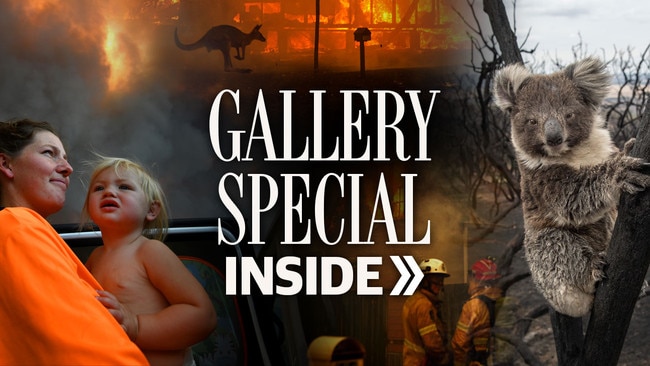Unflinching look at nature in crisis: Behind the lens on the fire front
For months, often at great personal risk, NewsCorp photographers have documented the bushfire crisis, their images conveying to audiences the enormity of the disaster. These are their stories from the front lines of an unprecedented tragedy.

Bushfire Support
Don't miss out on the headlines from Bushfire Support. Followed categories will be added to My News.
- ‘Are we going to die?’: Family saved from certain death
- To the bushfire towns: We’re for you
- Painful recovery for gutsy firefighters
It is one of the most haunting images of the Australian bushfire crisis – a defenceless joey frozen in time after being outrun by one of the many infernos that have ravaged our country this summer.
A heartbreaking symbol of the enormous toll these fires have left in their wake, the picture has been shared the world over and helped rally millions to get behind those suffering the most.
But so confronting was the joey’s death, trapped in a fence on an Adelaide Hills property, that News Corp photographer Brad Fleet almost didn’t press the button.
It was only when the veteran newsman decided he had a responsibility to document every angle of this unprecedented tragedy, no matter how graphic or disturbing, did he return and capture the scene.
“I walked past it the first time and didn’t take the photo and then went back to it and thought it just had to be documented,” he said.
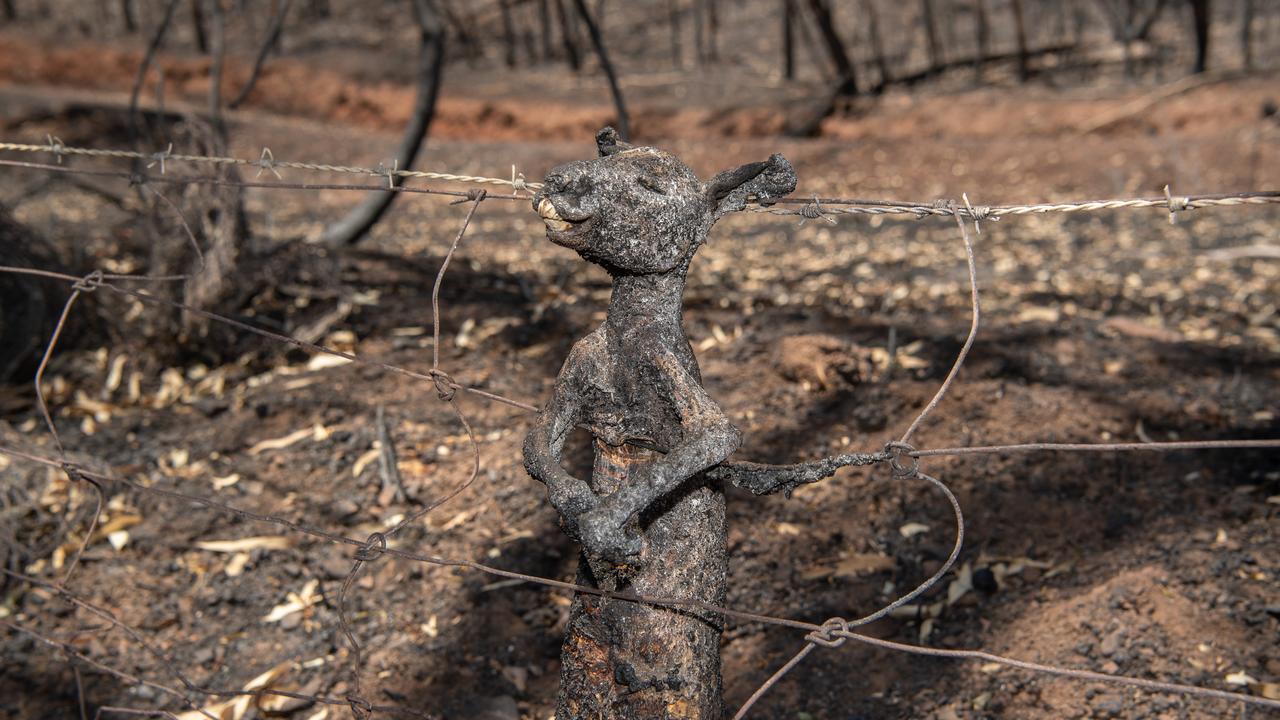
Fleet is one of more than 30 News Corp photographers who have been covering the bushfires across New South Wales, Victoria, South Australia and Queensland.
Their images in this picture special are just some of the thousands they shot, sometimes in treacherous conditions, as they documented this unprecedented crisis.
Fleet had been painstakingly documenting the aftermath of the deadly fires – homes decimated, crops destroyed, lives upturned — when a farmer told him of the haunting find he stumbled across on the outskirts of his property.
“I’ve been trying not to use the word surreal because it gets thrown around so much, but it looked like it was jumping along and it ran into the fence and then it was just frozen — there were no big signs of struggle,” he said.
No two days are ever the same for a news photographer and it’s an unwritten part of the job description that you have to be prepared to walk into situations others wouldn’t dare. Horrific murders, tragic collisions and catastrophic natural disasters.
With experience, those wielding a camera develop an invisible shield against some of the more graphic subjects they capture.
But every so often an image will come along that breaks through that armour and drives home the gravity of what they are witnessing.
That young joey, killed by an unyielding inferno that had already taken so much, was one of those moments for Fleet.
“I could only imagine he was chased up the gully by the fire and you don’t know how long it was trying to get through that fence or anything like that,” he reflected. “The crossing over of the arms, it’s sort of like he’s just given up and been taken by the fire.”
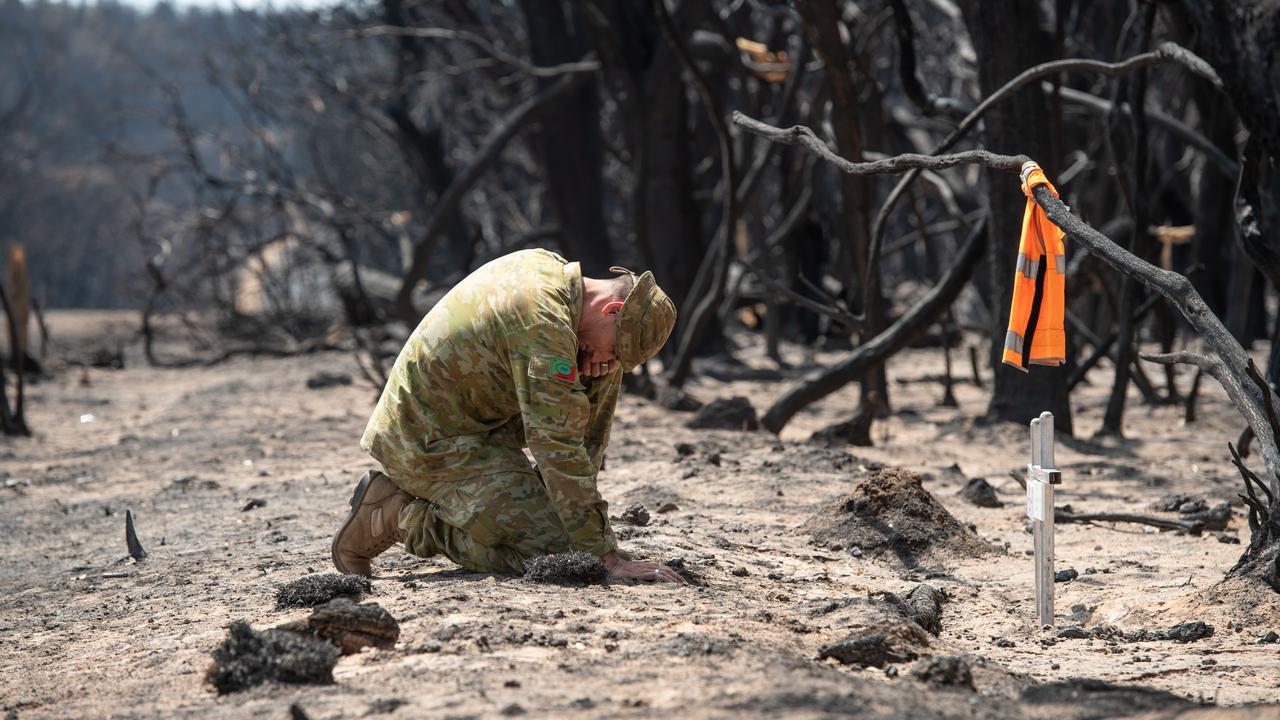
While visually recording the aftermath of the fires on Kangaroo Island, Fleet came across a soldier kneeling on the spot where bush pilot Dick Lang and his son, surgeon Clayton, died as they tried to escape the blaze.
“He was a cousin of Clayton and nephew of Dick and he went out there to pay his respects and put a couple of crosses as a tribute to his family,” he said. “He’s a reservist who has come out and taken part of the rebuild out there and what the Army is doing.”
Capturing the ferocity of the raw and relentless flames as they obliterate anything in their path is also vital in conveying to audiences the enormity of the disaster that has swept large swathes of the country.
Without those images of houses burning, terrified residents fleeing and the army of hero fire fighters risking literally everything to save people and property, the fires would be reduced to icons on a map and wouldn’t have the impact that drives people to question what can done to prevent this from happening again.
Despite being trained by experts at the Rural Fire Service, there in an inherent danger faced by journalists who enter the fire zone.
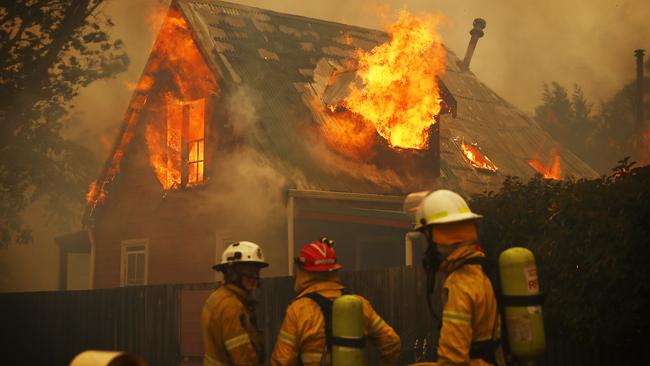
Sydney-based photographer Sam Ruttyn was sent to Balmoral in the Southern Highlands, a small hamlet being threatened by the destructive Green Wattle Creek fire.
Not long after arriving he witnessed first-hand just how fast this fire was moving and how difficult the conditions were facing residents and firefighters desperately working to save their homes.
“The fire as it came through was travelling as fast as the wind so you can imagine if it’s a 40km/h southerly, the flames were ripping through the bush pretty quick,” Ruttyn recalled. “By the time you saw the flames 500m down the road, they were on top of you the next time you turned around to look at them again. It was moving incredibly fast and it was loud.”
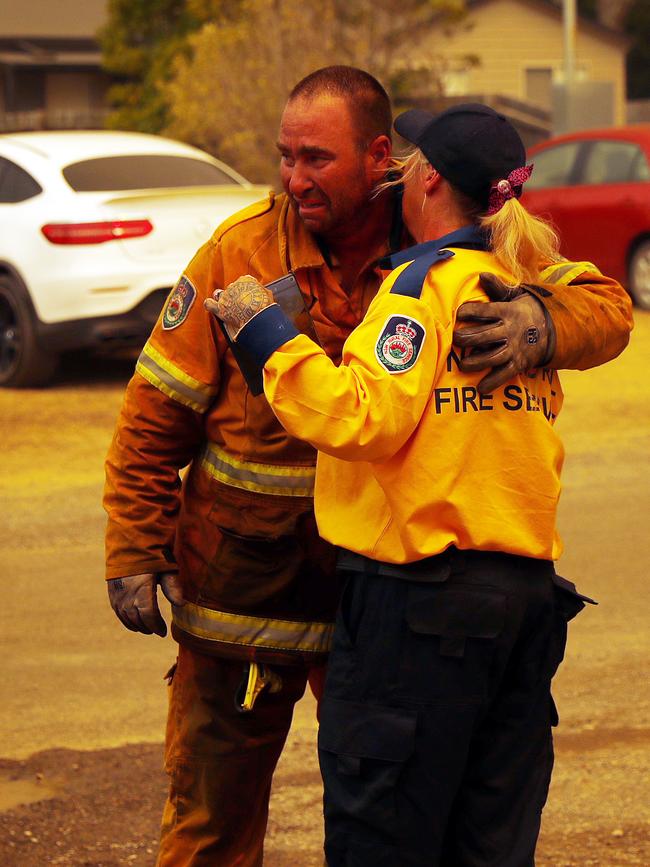
Ruttyn’s dramatic photo of a fireball exploding through the upstairs window of a Balmoral home gives readers an idea of just how terrifying and merciless the conditions were that faced fire crews.
“Once the original front came over the top of the town, once the fire had gone through, that’s when the fireys had to try and protect property,” he said. “That photo of the house that was exploding, they knew that was gone so they had to keep that under control but they also had to protect the houses next door to that.”
Despite having a job to do, being in these danger zones means things can arise that are more important than taking photos.
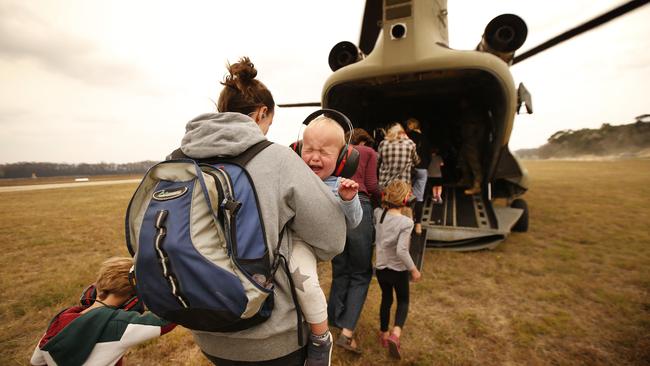
Photographer David Caird, who was covering the immediate aftermath of the fires that bore down on the coastal Victorian tourist town of Mallacoota, was darting about in the thick smoke when he noticed a woman holding a baby in the distance.
“I spotted her and she spotted me and she came to me fast with her baby,” he said. “Straight away she saw that I had a mask on and the smoke was so thick that morning. She said, ‘Where can I get masks from, do you know where I can get masks from, they’ve all run out’ and she started to panic a bit.
“I said, ‘You can have mine’ and put it on the baby and she said to me, ‘She’s a redhead so she’ll be firey, she won’t like it.’ And she didn’t like it,” he laughed.
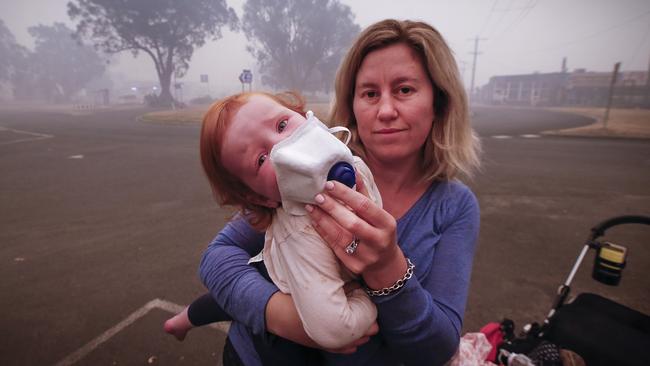
Caird, who covered the tragic Black Saturday fires that killed 173 and destroyed more than 2000 homes, had driven four hours from Melbourne to Lakes Entrance where he jumped on board a fishing boat for another four hour journey through rough seas to get to Mallacoota.
Mental preparation and planning is key to doing a job justice when heading towards a disaster zone, the experienced photographer said.
“It’s like going into a war zone, and Mallacoota really was like a war zone. You’ve got to mentally prepare yourself for what you expect and what you’re going to achieve from doing it,” he said.
“You don’t know what you’re going to come up against but you have a checklist of what you want to cover. That’s on the way there. When you get there that could actually all go to water or it can work perfectly for you.”
When he jumped off the boat, Caird headed straight to one of the worst affected streets and was immediately taken aback by just how random the destruction was.
“It was a really sad street unfortunately because one house would burn, the other house would be fine, the next house would burn and the other would be fine — it was very indiscriminate,” he said.
“It was a bit of a lotto on which house was going to get burnt and which wasn’t. And that’s pretty much how it was through the whole town.”
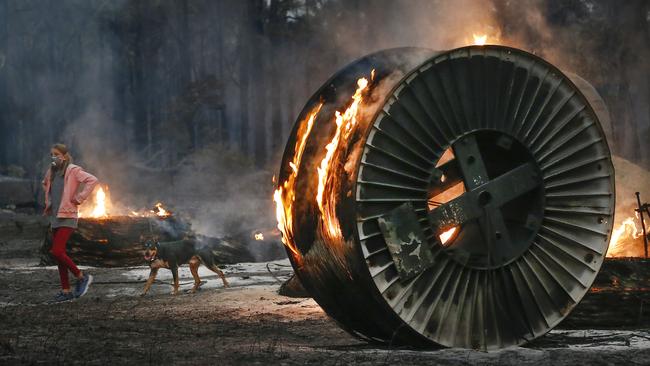
Late one afternoon while walking through a large property the fire had raced through, Caird spotted something quite surreal. Two young girls were out walking their dog through the blackened field.
Kids walking a dog wouldn’t get a second glance on an ordinary day, but with their immediate world blackened into an apocalyptic nightmare, this wasn’t an ordinary day.
“One of the girls is dressed in a pink outfit — pink jacket and colourful leggings. All this colour on her and surrounded by all this black and grey and trauma and looking at a dead animal,” Caird said.
“It looked like … not Alice In Wonderland but Alice in Horrorland. I took that photo and it became one of my favourites, it just summed up a lot.”

Most of the time photographers get sent to where the news is, but in some cases the news comes to the photographer.
Just ask Alex Coppel, a Melbourne-based News Corp photographer who was holidaying at his mum’s home in Malua Bay, just south of Bateman’s Bay on the NSW south coast.
“Working for the media when you’re ever dispatched to cover a fire you’re always three hours late, it’s already happened,” he said.
“In this case the news was coming to me. You don’t understand the severity of it until you look back and it’s got worldwide coverage.”
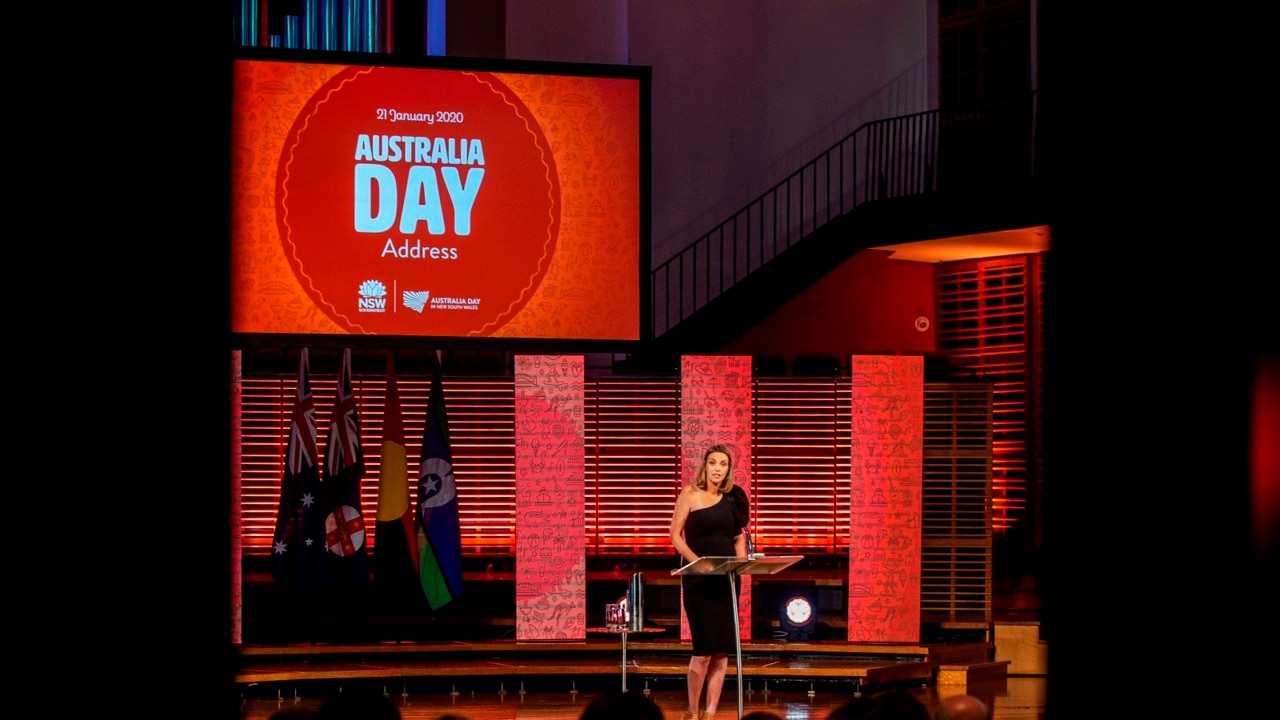
Aware of the fires in the general area but with no inkling they were in any danger, Coppel was enjoying some time off in the little slice of heaven he hopes to retire to one day.
When he woke on the morning of New Year’s Eve there was an alert calling for the residents of Mogo, a town about 20km inland from Malua Bay, to evacuate and soon people came streaming down the mountain.
As the day wore on the wind changed and put the fire on a dangerous path towards the thousands who had fled to the Bay.

More than a dozen friends and family had fled to Coppel’s house and as it drew closer, he struggled with the urge to capture the incredible scenes down at the beach.
“I was quite torn between getting the camera gear and going down to take pictures and actually watching my house,” he said. “There was a moment where I could see we weren’t in any danger so I went down to the beach, because up on the hill I could see thousands of people gathering on the beach.”
As the sky turned an eerie shade of dark red, Coppel captured a beach overflowing with locals and tourists, together with dogs, cats and horses as giant flames danced through the bush just across the bay.
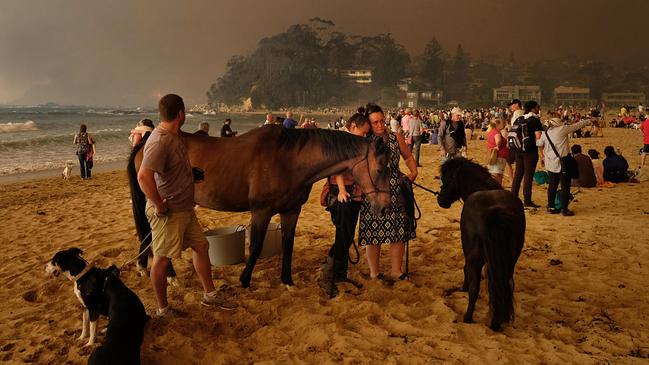
Despite the worrying conditions, those on the beach were strangely calm.
“It’s kind of weird. There’s one photo where there’s a wave breaking and there’s a guy sitting there with his dog and the headland’s burning beyond them,” Coppel said. “I almost expected for a surfer to be on that wave and just to go ‘what fire?’”
With reception and power out throughout the area, and a wind change again shifting the direction of the fire, Coppel spent just half an hour at the beach before he raced back to be with his family.
“I feel like I could have taken a hell of a lot more but the decision was to be with the family and the house and that was the right one,” he said.
“I couldn’t have lived with myself if I’d raced back and seen my family watching the house on fire and asking me where was I.”
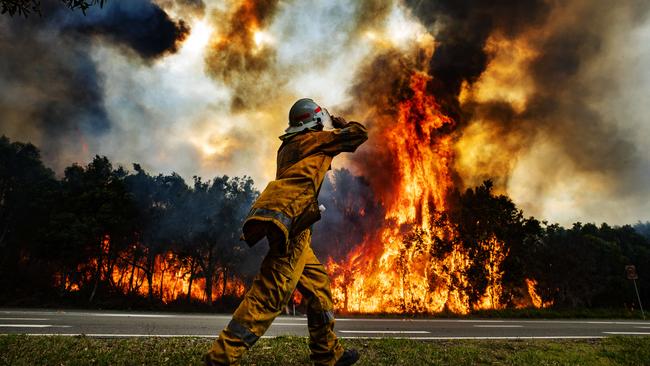
Lachie Millard is another photographer who had a close encounter with a raging fire while on a day off. The photographer was at home on the Sunshine Coast in September last year when a fire began racing towards his home.
After racing to grab his child from daycare, which was also in the line of the fire, he rushed back home to pack valuables into the car.
“Because my partner was at work and couldn’t be contacted I sort of had to be the responsible one for once,” he laughed. “After I knew I’d got everything important out of the house I was then able to get into work mode and went through the rest of the night.”
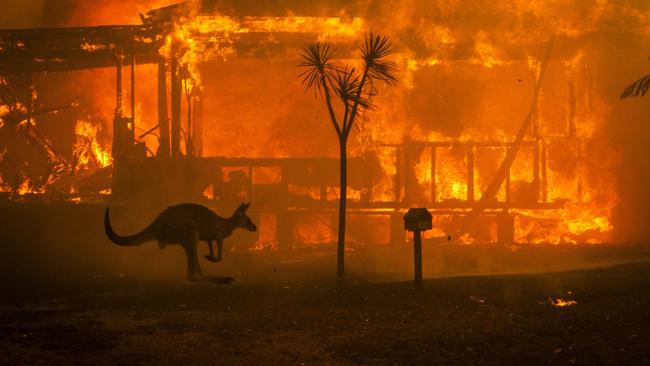
Although Millard was “resigned to the fact the house was gone”, firefighters worked through the night and stopped the flames just a few hundred metres from his front door.
Pictures from the many photographers across all the fire zones have captured the attention of media throughout the world.
Freelancer Matthew Abbott saw his incredible image of a kangaroo jumping in front of a fully engulfed home in the battered NSW south coast town of Conjola hit the front pages of newspapers like the New York Times in the US and The Guardian in the UK.
But in such circumstances, it’s difficult to celebrate an achievement you would usually shout about at the top of your lungs.
“It’s more about capturing the moment and hoping your photos make a difference,” Abbott said.

Dan Peled is no stranger to documenting some of the more turbulent moments in history. The Brisbane-based AAP photographer has shot the horrors of war, captured the landscape-changing destruction of cyclones and witnessed the damage caused by catastrophic floods, but bushfires easily rate as the scariest and most unpredictable of assignments for this veteran journalist.
Peled, whose haunting image of Sharnie Moren cradling 18-month old daughter Charlotte as the Nana Glen fire raged behind them in November was an early warning of the tragic summer ahead, didn’t hesitate when giving this frank assessment.
“I’ve covered conflict and I’ve covered many different natural disasters - cyclones and floods - and fire is by far the scariest,” he said. “It’s a sense of helplessness because you really feel that you’re against something that you can’t control.”
While he doesn’t want to diminish the seriousness of any of those other situations, the unpredictable nature of the fires and the speed at which conditions can change and threaten your life puts fires in a category of their own.
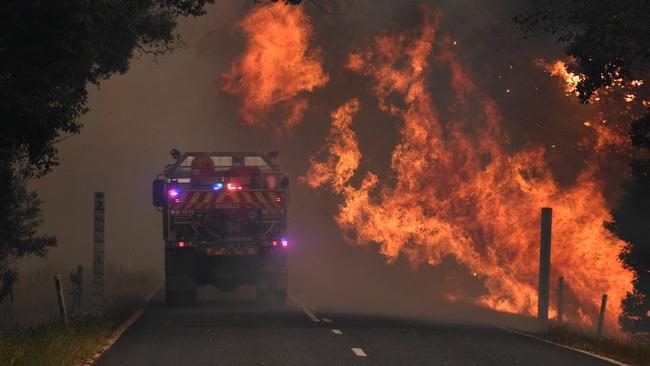
“If you’re in a conflict zone and there’s a shooting you can hide behind a concrete wall or you can make your way out of a situation,” he said. “If you’re facing a fire front, there’s no way to control it, you feel like you’re trapped and you really have to make quick decisions not to get hurt.”
Those decisions don’t have to be huge – the smallest of things that save even a fraction of time can be the difference between getting out unscathed or having the fire over-run you.
In the Nana Glen fire, the one which damaged the property of Oscar winner Russel Crowe, it was a simple move ahead of time that allowed Peled to make a speedy retreat.
“When I was shooting this fire coming off the hill, at some point I realised it was close and I turned my car around so it was facing the right way to get out of there so I don’t have to reverse or do a u-turn,” he said. “You really have to have an escape plan.”


